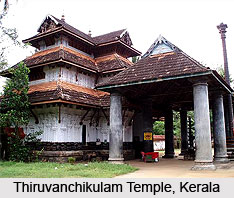 Thiruvanchikulam Temple is also known as `Mahadeva Temple` and it is situated in the region of Kodungallur, Thrissur District in Kerala and the temple is one of the Shaivite Thiruppathies in this Indian state out of the 274 ones in the entire country. Thiruvanchikulam Temple is the 266th Devaram Paadal Petra Shiva Sthalam in Malai Nadu and its presiding deity of its structure is Lord Shiva, the family deity of the Cochin royal family. Beautiful mural paintings decorate the interiors of this Indian temple and it is declared a protected monument by the Archaeological Survey of India or ASI.
Thiruvanchikulam Temple is also known as `Mahadeva Temple` and it is situated in the region of Kodungallur, Thrissur District in Kerala and the temple is one of the Shaivite Thiruppathies in this Indian state out of the 274 ones in the entire country. Thiruvanchikulam Temple is the 266th Devaram Paadal Petra Shiva Sthalam in Malai Nadu and its presiding deity of its structure is Lord Shiva, the family deity of the Cochin royal family. Beautiful mural paintings decorate the interiors of this Indian temple and it is declared a protected monument by the Archaeological Survey of India or ASI.
History of Thiruvanchikulam Temple
The ancient Tamil Sangam literature contains several references of this temple, along with the names of Ilango Adikal and Sundara Murti Nayanar, the former being a Chera prince who was also the brother of Cheran Chenkuttavan. Thiruvanchikulam Temple is amongst the most ancient temples of Lord Shiva and it is believed that Lord Shiva used to reside in its premises with his whole family. The temple is also associated to the Chidambaram Temple in the state of Tamil Nadu. Kulasekharas was the capital city near Mahodaypuram which had been erected close to the temple. High fortress surrounds the temple on all its sides, apart from palaces and pathways which surrounded the temple. However, this temple had been destroyed considerably during the invasion of Tipu Sultan of Kerala. During this time, all the jewelleries comprising gold and the copper roofing were plundered. Following the arrival of Travancore Army of Dalawa Keshavadas Pillai, the Muslim troops retreated from the temple grounds and the temple was reconstructed by Paliath Achan of Kochi or Perumpadappu Swaroopam.
This article is a stub. You can enrich by adding more information to it. Send your Write Up to content@indianetzone.com





















